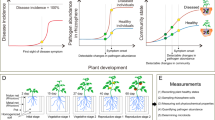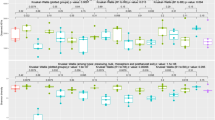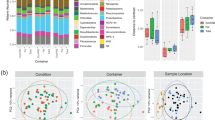Abstract
We examined succession of the rhizosphere microbiota of three model plants (Arabidopsis, Medicago and Brachypodium) in compost and sand and three crops (Brassica, Pisum and Triticum) in compost alone. We used serial inoculation of 24 independent replicate microcosms over three plant generations for each plant/soil combination. Stochastic variation between replicates was surprisingly weak and by the third generation, replicate microcosms for each plant had communities that were very similar to each other but different to those of other plants or unplanted soil. Microbiota diversity remained high in compost, but declined drastically in sand, with bacterial opportunists and putative autotrophs becoming dominant. These dramatic differences indicate that many microbes cannot thrive on plant exudates alone and presumably also require carbon sources and/or nutrients from soil. Arabidopsis had the weakest influence on its microbiota and in compost replicate microcosms converged on three alternative community compositions rather than a single distinctive community. Organisms selected in rhizospheres can have positive or negative effects. Two abundant bacteria are shown to promote plant growth, but in Brassica the pathogen Olpidium brassicae came to dominate the fungal community. So plants exert strong selection on the rhizosphere microbiota but soil composition is critical to its stability. microbial succession/ plant–microbe interactions/rhizosphere microbiota/selection.
Similar content being viewed by others
Log in or create a free account to read this content
Gain free access to this article, as well as selected content from this journal and more on nature.com
or
Accession codes
References
Adrangi S, Faramarzi MA, Shahverdi AR, Sepehrizadeh Z . (2010). Purification and characterization of two extracellular endochitinases from Massilia timonae. Carbohydr Res 345: 402–407.
Bent SJ, Forney LJ . (2008). The tragedy of the uncommon: understanding limitations in the analysis of microbial diversity. ISME J 2: 689–695.
Berg G, Smalla K . (2009). Plant species and soil type cooperatively shape the structure and function of microbial communities in the rhizosphere. FEMS Microbiol Ecol 68: 1–13.
Bertani G . (1951). Studies on lysogenesis. I. The mode of phage liberation by lysogenic Escherichia coli. J Bacteriol 62: 293–300.
Bodenhausen N, Horton MW, Bergelson J . (2013). Bacterial communities associated with the leaves and the roots of Arabidopsis thaliana. PLoS One 8: e56329.
Bressan M, Roncato MA, Bellvert F, Comte G, Haichar FZ, Achouak W et al. (2009). Exogenous glucosinolate produced by Arabidopsis thaliana has an impact on microbes in the rhizosphere and plant roots. ISME J 3: 1243–1257.
Buee M, Reich M, Murat C, Morin E, Nilsson RH, Uroz S et al. (2009). 454 Pyrosequencing analyses of forest soils reveal an unexpectedly high fungal diversity. New Phytol 184: 449–456.
Bulgarelli D, Rott M, Schlaeppi K, Ver Loren van Themaat E, Ahmadinejad N, Assenza F et al. (2012). Revealing structure and assembly cues for Arabidopsis root-inhabiting bacterial microbiota. Nature 488: 91–95.
Bulgarelli D, Schlaeppi K, Spaepen S, van Themaat EVL, Schulze-Lefert P . (2013). Structure and functions of the bacterial microbiota of plants. Annu Rev Plant Biol 64: 807–838.
Cardinale M, Brusetti L, Quatrini P, Borin S, Puglia AM, Rizzi A et al. (2004). Comparison of different primer sets for use in automated ribosomal intergenic spacer analysis of complex bacterial communities. Appl Environ Microbiol 70: 6147–6156.
Demoling F, Figueroa D, Bååth E . (2007). Comparison of factors limiting bacterial growth in different soils. Soil Biol and Biochem 39: 2485–2495.
Dennis PG, Miller AJ, Hirsch PR . (2010). Are root exudates more important than other sources of rhizodeposits in structuring rhizosphere bacterial communities? FEMS Microbiol Ecol 72: 313–327.
Edgar RC . (2010). Search and clustering orders of magnitude faster than BLAST. Bioinformatics 26: 2460–2461.
Eilers KG, Lauber CL, Knight R, Fierer N . (2010). Shifts in bacterial community structure associated with inputs of low molecular weight carbon compounds to soil. Soil Biol Biochem 42: 896–903.
Faramarzi M.A. FM, Tabatabaei Yazdi M, Adrangi S, Jami-alahmadi K, Tasharrofi N, Azizmohseni F . (2009). Optimization of cultural condtions for production of chitinase by a soil isolate of Massilia timonae. Biotechnology 8: 99–93.
Fisher MM, Triplett EW . (1999). Automated approach for ribosomal intergenic spacer analysis of microbial diversity and its application to freshwater bacterial communities. Appl Environ Microbiol 65: 4630–4636.
Griffiths RI, Whiteley AS, O'Donnell AG, Bailey MJ . (2000). Rapid method for coextraction of DNA and RNA from natural environments for analysis of ribosomal DNA- and rRNA-based microbial community composition. Appl Environ Microbiol 66: 5488–5491.
Hamady M, Knight R . (2009). Microbial community profiling for human microbiome projects: tools, techniques, and challenges. Genome Res 19: 1141–1152.
Hamilton MJ, Weingarden AR, Unno T, Khoruts A, Sadowsky MJ . (2013). High-throughput DNA sequence analysis reveals stable engraftment of gut microbiota following transplantation of previously frozen fecal bacteria. Gut Microbes 4: 125–135.
Hartwright LM, Hunter PJ, Walsh JA . (2010). A comparison of Olpidium isolates from a range of host plants using internal transcribed spacer sequence analysis and host range studies. Fungal Biol 114: 26–33.
Hawes MC, Gunawardena U, Miyasaka S, Zhao X . (2000). The role of root border cells in plant defense. Trends Plant Sci 5: 128–133.
Hilton S, Bennett AJ, Keane G, Bending GD, Chandler D, Stobart R et al. (2013). Impact of shortened crop rotation of oilseed rape on soil and rhizosphere microbial diversity in relation to yield decline. PLoS One 8: e59859.
Huson DH, Richter DC, Mitra S, Auch AF, Schuster SC . (2009). Methods for comparative metagenomics. BMC Bioinform 10: S12.
James TY, Letcher PM, Longcore JE, Mozley-Standridge SE, Porter D, Powell MJ et al. (2006). A molecular phylogeny of the flagellated fungi (Chytridiomycota) and description of a new phylum (Blastocladiomycota). Mycologia 98: 860–871.
Jones DL, Nguyen C, Finlay RD . (2009). Carbon flow in the rhizosphere: carbon trading at the soil–root interface. Plant Soil 321: 5–33.
Kinkel LL, Bakker MG, Schlatter DC . (2011). A coevolutionary framework for managing disease-suppressive soils. Annu Rev Phytopathol 49: 47–67.
Klein E, Ofek M, Katan J, Minz D, Gamliel A . (2013). Soil suppressiveness to fusarium disease: shifts in root microbiome associated with reduction of pathogen root colonization. Phytopathology 103: 23–33.
Knight R, Jansson J, Field D, Fierer N, Desai N, Fuhrman JA et al. (2012). Unlocking the potential of metagenomics through replicated experimental design. Nat Biotechnol 30: 513–520.
Lambert B, Meire P, Joos H, Lens P, Swings J . (1990). Fast-growing, aerobic, heterotrophic bacteria from the rhizosphere of young sugar beet plants. Appl Environ Microbiol 56: 3375–3381.
Lanfranco L, Young JP . (2012). Genetic and genomic glimpses of the elusive arbuscular mycorrhizal fungi. Curr Opin Plant Biol 15: 454–461.
Lauber CL, Hamady M, Knight R, Fierer N . (2009). Pyrosequencing-based assessment of soil pH as a predictor of soil bacterial community structure at the continental scale. Appl Environ Microbiol 75: 5111–5120.
Lebreton L, Gosme M, Lucas P, Guillerm-Erckelboudt A-Y, Sarniguet A . (2007). Linera relationship bewteen Gaeumannomyces graminis var. tritici Ggt gentypic frequencies and diverse severity on wheat roots in the field. Environ Microbiol 9: 492–499.
Lugtenberg B, Kamilova F . (2009). Plant-growth-promoting rhizobacteria. Annu Rev Microbiol 63: 541–556.
Lundberg DS, Lebeis SL, Paredes SH, Yourstone S, Gehring J, Malfatti S et al. (2012). Defining the core Arabidopsis thaliana root microbiome. Nature 488: 86–90.
Manter DK, Delgado JA, Holm DG, Stong RA . (2010). Pyrosequencing reveals a highly diverse and cultivar-specific bacterial endophyte community in potato roots. Microb Ecol 60: 157–166.
Mendes R, Kruijt M, de Bruijn I, Dekkers E, van der Voort M, Schneider JH et al. (2011). Deciphering the rhizosphere microbiome for disease-suppressive bacteria. Science 332: 1097–1100.
Murashige T, Skoog F . (1962). A revised medium for rapid growth and bioassays with tobaco tissue cultures. Physiol Plant 15: 473–497.
Ngugi DK, Stingl U . (2012). Combined analyses of the ITS loci and the corresponding 16 S rRNA genes reveal high micro- and macrodiversity of SAR11 populations in the Red Sea. PLoS One 7: e50274.
Nuccio EE, Hodge A, Pett-Ridge J, Herman DJ, Weber PK, Firestone MK . (2013). An arbuscular mycorrhizal fungus significantly modifies the soil bacterial community and nitrogen cycling during litter decomposition. Environ Microbiol 15: 1870–1881.
O'Reilly T, Niven DF . (1986). Tryptone-yeast extract broth as a culture medium for Haemophilus pleuropneumoniae and Haemophilus parasuis to be used as challenge inocula. Can J Vet Res 50: 441–443.
Ofek M, Hadar Y, Minz D . (2012). Ecology of root colonizing Massilia (Oxalobacteraceae). PLoS One 7: e40117.
Osborne CA, Zwart AB, Broadhurst LM, Young AG, Richardson AE . (2011). The influence of sampling strategies and spatial variation on the detected soil bacterial communities under three different land-use types. FEMS Microbiol Ecol 78: 70–79.
Poole PS, Blyth A, Reid CJ, Walters K . (1994a). myo-Inositol catabolism and catabolite regulation in Rhizobium leguminosarum bv. viciae. Microbiology 140: 2787–2795.
Poole PS, Schofield NA, Reid CJ, Drew EM, Walshaw DL . (1994b). Identification of chromosomal genes located downstream of dctD that affect the requirement for calcium and the lipopolysaccharide layer of Rhizobium leguminosarum. Microbiology 140: 2797–2809.
R Development Core Team. (2008) R: A Language and Environment for Statistical Computing. R Foundation for Statistical Computing: Vienna, Austria, http://www.R-project.org.
Sharma S, Aneja MK, Mayer J, Munch JC, Schloter M . (2005). Characterization of bacterial community structure in rhizosphere soil of grain legumes. Microb Ecol 49: 407–415.
Smith CJ, Danilowicz BS, Clear AK, Costello FJ, Wilson B, Meijer WG . (2005). T-Align, a web-based tool for comparison of multiple terminal restriction fragment length polymorphism profiles. FEMS Microbiol Ecol 54: 375–380.
Sonderby IE, Hansen BG, Bjarnholt N, Ticconi C, Halkier BA, Kliebenstein DJ . (2007). A systems biology approach identifies a R2R3 MYB gene subfamily with distinct and overlapping functions in regulation of aliphatic glucosinolates. PLoS One 2: e1322.
Sutherland JP . (1974). Multiple stable states in natural communities. Am Nat 108: 859–873.
Swenson W, Wilson DS, Elias R . (2000). Artificial ecosystem selection. Proc Natl Acad Sci USA 97: 9110–9114.
Taghavi S, Garafola C, Monchy S, Newman L, Hoffman A, Weyens N et al. (2009). Genome survey and characterization of endophytic bacteria exhibiting a beneficial effect on growth and development of poplar trees. Appl Environ Microbiol 75: 748–757.
Terpolilli JJ, Hood GA, Poole PS . (2012). What determines the efficiency of N(2)-fixing Rhizobium-legume symbioses? Adv Microb Physiol 60: 325–389.
Turner TR, James EK, Poole PS . (2013a). The plant microbiome. Genome Biol 14: 209.
Turner TR, Ramakrishnan K, Walshaw J, Heavens D, Alston M, Swarbreck D et al. (2013b). Comparative metatranscriptomics reveals kingdom level changes in the rhizosphere microbiome of plants. ISME J 7: 2248–2258.
Udvardi M, Poole PS . (2013). Transport and metabolism in legume-rhizobia symbioses. Annu Rev Plant Biol 64: 781–805.
Van der Ent S, Van Wees SC, Pieterse CM . (2009). Jasmonate signaling in plant interactions with resistance-inducing beneficial microbes. Phytochemistry 70: 1581–1588.
Wooley JC, Godzik A, Friedberg I . (2010). A primer on metagenomics. PLoS Comput Biol 6: e1000667.
Wright ES, Yilmaz LS, Noguera DR . (2012). DECIPHER, a search-based approach to chimera identification for 16S rRNA sequences. Appl Environ Microbiol 78: 717–725.
Yin C, Hulbert SH, Schroeder KL, Mavrodi O, Mavrodi D, Dhingra A et al. (2013). Role of bacterial communities in the natural suppression of Rhizoctonia solani bare patch disease of wheat (Triticum aestivum L.). Appl Environ Microbiol 79: 7428–7438.
Yuan H, Ge T, Chen C, O'Donnell AG, Wu J . (2012). Significant role for microbial autotrophy in the sequestration of soil carbon. Appl Environ Microbiol 78: 2328–2336.
Acknowledgements
The research was funded by Zuckerman Endowment Fund and UK Biotechnology and Biological Sciences Research Council (BBSRC) grant BB/K001868/1. We thank Darren Heavens (The Genome Analysis Centre) and John Walshaw (John Innes Centre) for sequencing and initial data analysis, Rob Green (John Innes Centre) for help with figures, Alison East (John Innes Centre) for help with the manuscript and Peter Sterk (EMBL-EBI) for data submission. Metagenomic sequence data have been submitted to the EMBL databases under accession PRJEB7318.
Author information
Authors and Affiliations
Corresponding author
Ethics declarations
Competing interests
The authors declare no conflict of interest.
Additional information
Supplementary Information accompanies this paper on The ISME Journal website
Supplementary information
Rights and permissions
About this article
Cite this article
Tkacz, A., Cheema, J., Chandra, G. et al. Stability and succession of the rhizosphere microbiota depends upon plant type and soil composition. ISME J 9, 2349–2359 (2015). https://doi.org/10.1038/ismej.2015.41
Received:
Revised:
Accepted:
Published:
Issue date:
DOI: https://doi.org/10.1038/ismej.2015.41
This article is cited by
-
Different responses of soil fauna gut and plant rhizosphere microbiomes to manure applications
Soil Ecology Letters (2024)
-
The Arabidopsis holobiont: a (re)source of insights to understand the amazing world of plant–microbe interactions
Environmental Microbiome (2023)
-
Astragalus-cultivated soil was a suitable bed soil for nurturing Angelica sinensis seedlings from the rhizosphere microbiome perspective
Scientific Reports (2023)
-
Graphitic carbon nitride alleviates cadmium toxicity to microbial communities in soybean rhizosphere
Environmental Science and Pollution Research (2023)
-
Rhizosphere Microorganisms and Soil Physicochemical Properties of Restored Wetland Plant Communities at Cutting Slash of Populus deltoides in Dongting Lake
Wetlands (2023)



